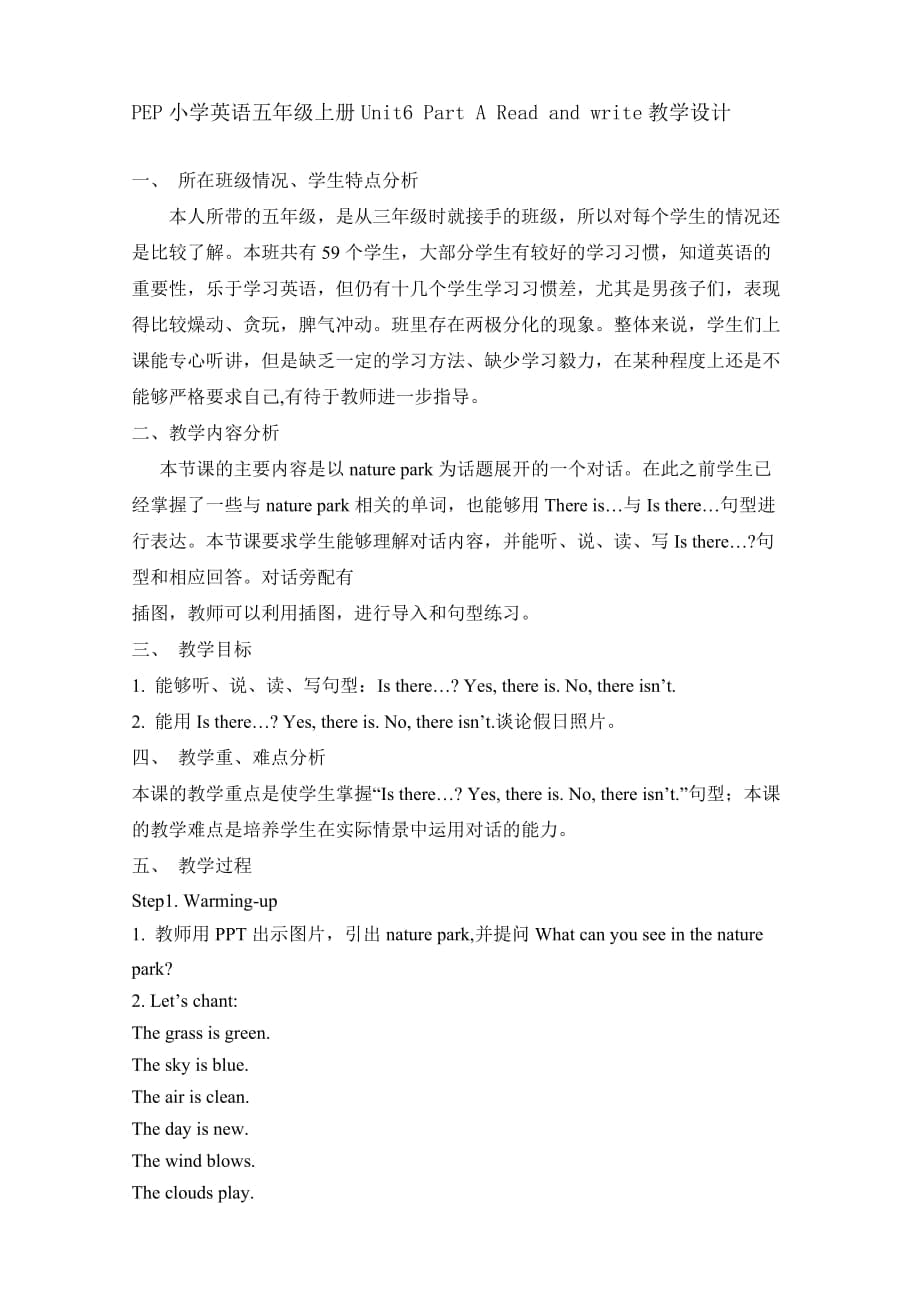《pep小學(xué)英語五年級(jí)上冊(cè)u(píng)nit6 part a read and write教學(xué)設(shè)計(jì)》由會(huì)員分享��,可在線閱讀�����,更多相關(guān)《pep小學(xué)英語五年級(jí)上冊(cè)u(píng)nit6 part a read and write教學(xué)設(shè)計(jì)(3頁珍藏版)》請(qǐng)?jiān)谘b配圖網(wǎng)上搜索����。
1、PEP小學(xué)英語五年級(jí)上冊(cè)Unit6 Part A Read and write教學(xué)設(shè)計(jì)一��、 所在班級(jí)情況��、學(xué)生特點(diǎn)分析本人所帶的五年級(jí)�����,是從三年級(jí)時(shí)就接手的班級(jí)�����,所以對(duì)每個(gè)學(xué)生的情況還是比較了解���。本班共有59個(gè)學(xué)生�����,大部分學(xué)生有較好的學(xué)習(xí)習(xí)慣�����,知道英語的重要性����,樂于學(xué)習(xí)英語,但仍有十幾個(gè)學(xué)生學(xué)習(xí)習(xí)慣差��,尤其是男孩子們�,表現(xiàn)得比較燥動(dòng)、貪玩���,脾氣沖動(dòng)����。班里存在兩極分化的現(xiàn)象����。整體來說,學(xué)生們上課能專心聽講�����,但是缺乏一定的學(xué)習(xí)方法����、缺少學(xué)習(xí)毅力��,在某種程度上還是不能夠嚴(yán)格要求自己,有待于教師進(jìn)一步指導(dǎo)。二�����、教學(xué)內(nèi)容分析本節(jié)課的主要內(nèi)容是以nature park為話題展開的一個(gè)對(duì)話���。在此之前學(xué)生已經(jīng)
2�、掌握了一些與nature park相關(guān)的單詞�,也能夠用There is與Is there句型進(jìn)行表達(dá)。本節(jié)課要求學(xué)生能夠理解對(duì)話內(nèi)容���,并能聽�����、說��、讀�����、寫Is there?句型和相應(yīng)回答�����。對(duì)話旁配有插圖����,教師可以利用插圖,進(jìn)行導(dǎo)入和句型練習(xí)�����。三���、 教學(xué)目標(biāo)1. 能夠聽����、說���、讀�����、寫句型:Is there? Yes, there is. No, there isnt.2. 能用Is there? Yes, there is. No, there isnt.談?wù)摷偃照掌?���。四?教學(xué)重、難點(diǎn)分析本課的教學(xué)重點(diǎn)是使學(xué)生掌握“Is there? Yes, there is. No, there isnt.”
3����、句型;本課的教學(xué)難點(diǎn)是培養(yǎng)學(xué)生在實(shí)際情景中運(yùn)用對(duì)話的能力�����。五�����、 教學(xué)過程Step1. Warming-up1. 教師用PPT出示圖片�����,引出nature park,并提問What can you see in the nature park?2. Lets chant:The grass is green.The sky is blue.The air is clean.The day is new.The wind blows.The clouds play.The river flows.Beautiful day, beautiful day!Step2. Lead-in & Before
4���、-reading1. 教師出示只有forest和river的nature park. T: Is there a forest in the park?S1: Yes, there is.T: Is there a mountain in the park?S2: No, there isnt.T: Is there a river in the park?S3: Yes, there is.T: Is there a lake in the park?S4: No, there isnt.2. Lets chant:Forest,forest Is there a forest? Mount
5�����、ain,mountain Is there a mountain? River�����,river Is there a river? Lake���,lake Is there a lake?3.男女生分組對(duì)Lets chant進(jìn)行問答G: Is there a forest in the park?B: Yes, there is.G: Is there a mountain in the park?B: No, there isnt.B: Is there a river in the park?G: Yes, there is.B: Is there a lake in the park?G: No
6����、, there isnt.Step3. During-reading1.出示Read and write旁邊的插圖T: Who is he?Ss: He is Wu Yifan.T: Yes, this is Wu Yifans picture. This is Wu Yifans holiday picture. Is it a nature park? Ss: Yes, it is.T: Is there a forest in the park? Now read the dialogue quickly and find out the answer.學(xué)生初讀課文���,并找到答案Yes,
7�、there is.2. Tick or cross(1) There is a river in the park. ()(2) There is a lake in the park. ()(3) Wu Yifan doesnt like this park. ()(4) This park is pretty. ()Ask a student to show his answers and check together. 學(xué)生第二次閱讀���,更詳盡地理解閱讀內(nèi)容����,同時(shí)鼓勵(lì)學(xué)生找出相關(guān)根據(jù)����,訓(xùn)練學(xué)生的邏輯思維能力。3. Finish the sentences(1) Is there a _ i
8�����、n the park? Yes,_.(2) Is there a _? No,_.要求學(xué)生獨(dú)立完成句子,同桌校對(duì)����,讓個(gè)別同學(xué)在黑板上寫下他們的答案。4. Listen and repeatStep4. After-readingRole play八��、課堂練習(xí)出示課件���,另一幅nature park的圖,讓同桌兩人合作����,一個(gè)學(xué)生就圖片內(nèi)容先寫出問題,然后同桌就問題寫回答����。到前面展示對(duì)話。九����、作業(yè)1. Listen to tape and read the dialogue.2. Write the sentences.3. Talk about your pictures.教學(xué)反思本節(jié)我始終堅(jiān)持“任務(wù)型教學(xué)”的教育理念,通過三次閱讀課文�,對(duì)學(xué)生提出不同層次的問題,讓學(xué)生帶著不同的任務(wù)去學(xué)習(xí),學(xué)生通過快速閱讀并圈出關(guān)鍵詞能很快找到問題的答案�����,無需一詞一句地閱讀語篇��。學(xué)生在完成一個(gè)個(gè)任務(wù)中�����,體驗(yàn)著成功的快樂��。本節(jié)課還有以下幾個(gè)特點(diǎn):1. 突出合作的教學(xué)理念�;2. 突出以學(xué)生為主體的教學(xué)理念;3. 突出學(xué)以致用的教學(xué)理念��。
 pep小學(xué)英語五年級(jí)上冊(cè)u(píng)nit6 part a read and write教學(xué)設(shè)計(jì)
pep小學(xué)英語五年級(jí)上冊(cè)u(píng)nit6 part a read and write教學(xué)設(shè)計(jì)

